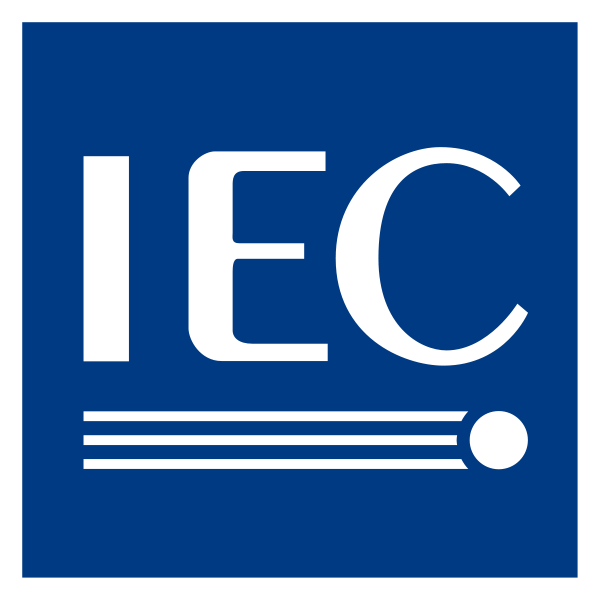International Electrotechnical Commission
| International Electrotechnical Commission | |
|---|---|
 Logo of the International Electrotechnical Commission | |
| Abbreviation | IEC |
| Formation | June 26, 1906[1] |
| Type | International non-governmental organization |
| Purpose/focus | Standards development |
| Headquarters | 3, rue de Varembé, Geneva |
| Location | Switzerland |
| President | Junji Nomura |
| Website | iec.ch |
The International Electrotechnical Commission (IEC) is a non-profit, non-governmental international standards organization that prepares and publishes international standards for many electrical devices, electronics, and other electrotechnology.[2] IEC standards cover a vast range of technologies from power generation, transmission, and distribution to home appliances and office equipment, semiconductors, fibre optics, batteries, solar energy systems, marine energy systems, and nanotechnology. The IEC also manages three global conformity assessment systems that certify whether equipment, systems, or components conform to its international standards.
The IEC charter embraces all electrotechnologies, including energy production and distribution systems, electronics, magnetic and electromagnetic devices, electroacoustic equipment, multimedia tools, telecommunication systems, and medical technology.[3] The IEC also performs research and investigation into associated general disciplines such as terminology and symbols, electromagnetic compatibility (by its Advisory Committee on Electromagnetic Compatibility, ACEC), measurement and performance, research and development, safety, and the environmental sciences.
History
The IEC was inspired by the Resolution of the Chamber of Government Delegates at the International Electrical Congress of St. Louis in September 1904. The Chamber of Delegates consisted of a group of scientists and engineers from 15 countries, including the Argentine Republic, France, Germany, Great Britain, Switzerland and the United States, and they strove for internationally accepted electrical and electronics nomenclature and ratings.[4][5][6][1] After much discussion among their groups, most of the Chamber of Delegates returned to London for the inaugural meeting of the IEC on June 26, 1906, with the first item of business being "to constitute the Commission by adopting a set of rules."[1] Those rules were finalized in 1908.[2]
The IEC was instrumental in developing and distributing standards for units of measurement in 1930, particularly the Gauss, Hertz, and Weber. They also proposed a system of standards, the Giorgi System, which ultimately became the SI, or Système International d’unités (in English, the International System of Units). In 1938, it published its first version of the International Electrotechnical Vocabulary (IEV; today known as the Electropedia), a multilingual international vocabulary to unify electrical terminology, which remains an important work in electrical and electronic industries today.[7]
In 1948, the commission moved its headquarters from London to Geneva. Afterwards, the organization saw its number of technical committees grow from 34 to 80 by 1980, expanding into new technologies like capacitors, resistors, semiconductors, medical systems, and radio-communication systems.[7]
Membership and organization
The IEC is classified by the Swiss Civil Code as a corporate association with legal entity.[2]
IEC's membership comprises some 10,000 electrical and electronics experts from industry, government, academia, test labs, and others with an interest in the subject. Currently, 82 countries are full or associate members[8], while 83 others participate in the Affiliate Country Programme, which is not a form of membership but is designed to help industrializing countries get involved with the IEC.[9]
The 2014 President of the IEC is Junji Nomura, with James E. Matthews III serving as Vice-president.[10]
Notes
An element or two of this article is reused from the Wikipedia article.
References
- ↑ 1.0 1.1 1.2 Frary, Mark. "In the beginning...: The founding of the IEC". IEC History. International Electrotechnical Commission. http://www.iec.ch/about/history/beginning/founding_iec.htm. Retrieved 27 March 2014.
- ↑ 2.0 2.1 2.2 "Statutes and Rules of Procedure" (PDF). International Electrotechnical Commission. 11 January 2013. http://www.iec.ch/members_experts/refdocs/iec/stat-2001e.pdf. Retrieved 27 March 2014.
- ↑ "Technology sectors". International Electrotechnical Commission. http://www.iec.ch/technology/. Retrieved 27 March 2014.
- ↑ "U.S. National Committee of the International Electrotechnical Commission" (PDF). American National Standards Institute. 2004. http://publicaa.ansi.org/sites/apdl/Documents/News%20and%20Publications/Brochures/ANSI-USNC-Intro-04.pdf. Retrieved 26 March 2014.
- ↑ "IEC Scheme for Certification to Standards relating to Equipment for use in Explosive Atmospheres" (PDF). International Electrotechnical Commission. November 2007. http://www.iecex.com/docs/iecex04%7Bed1%200%7Den_Mark_Regulations.pdf. Retrieved 26 March 2014.
- ↑ "ANSI: Historical Overview". American National Standards Institute. http://www.ansi.org/about_ansi/introduction/history.aspx?menuid=1. Retrieved 26 March 2014.
- ↑ 7.0 7.1 "Overview: Summary". IEC History. International Electrotechnical Commission. http://www.iec.ch/about/history/overview/. Retrieved 27 March 2014.
- ↑ "Who we are > Members > List of members". International Electrotechnical Commission. http://www.iec.ch/dyn/www/f?p=103:5:0. Retrieved 27 March 2014.
- ↑ "IEC Affiliates: List of IEC Affiliate Country Programme Participants". International Electrotechnical Commission. http://www.iec.ch/dyn/www/f?p=103:9:0. Retrieved 27 March 2014.
- ↑ "Who we are > Officers". International Electrotechnical Commission. http://www.iec.ch/about/profile/officers.htm. Retrieved 27 March 2014.









